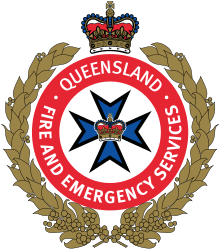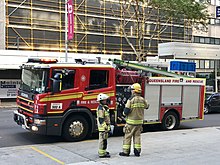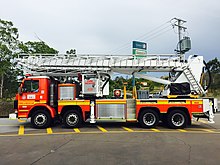Queensland Fire and Emergency Services
The Queensland Fire and Emergency Services (QFES) is the primary provider of fire and emergency services in Queensland. The QFES was established in 2013 to improve the coordination and planning of emergency services, adopting an "all hazards" approach to emergency management.
 | |
| Department overview | |
|---|---|
| Formed | 1860 |
| Jurisdiction | Queensland Government |
| Headquarters | Kedron, Queensland, Australia |
| Employees |
|
| Minister responsible |
|
| Department executive |
|
| Child agencies |
|
| Website | qfes |
QFES headquarters are located in the Emergency Services Complex Kedron, Brisbane.
The Department of Community Safety formally had joint coordination control until a merger in 2014.
- Queensland Fire and Rescue Service (QFRS) 2014 – Current Queensland Fire and Rescue Authority1997–2001 and Queensland Fire Service 1990–1997.
- Rural Fire Service (RFSQ) 1927 – Current
- Queensland State Emergency Service (QSES) 1974 – Current, Civil Defense Organisation 1961 – 1973
The 20,200 QFES personnel are 2,200 full-time professional firefighters and 2,000 on call auxiliary Firefighters, 9,000 Rural Fire Service volunteers and 6,000 State Emergency Service volunteers. QFES front-line operations is supported by a number of non-operational administration staff throughout the State.
The minister responsible is the Honourable Craig Crawford , Minister for Fire and Emergency Services.
QFES is currently led by Commissioner Greg Leach, formerly a member of the Country Fire Authority, Ambulance Victoria and the Metropolitan Fire Brigade (Melbourne).[1]
History
The QFES is the result of 150 years of evolution in Queensland's firefighting services; in fact the QFS was born in 1860 after a fire destroyed a Brisbane cabinet making workshop. The early years were tough for the Brisbane Fire Brigade and it was not until 1889 that the first firemen was employed.
The first legislation for rural fire management was the Act to Prevent the Careless Use of Fire 1865, and for state fire management, the Fire Brigades Act 1876. In 1990, the Queensland Fire Service and the Rural Fires Council were formed replacing the 81 Fire Boards in local government areas and the Rural Fires Board; this was the first step in creating a single fire service for Queensland.
In 1997, it became the Queensland Fire and Rescue Authority and 2001 saw another name change to the current Queensland Fire and Rescue Service.
In 2013, QFRS merged with EMQ and the Corporate Services Division of the Department of Community Safety to become the Queensland Fire and Emergency Services, encompassing Queensland Fire and Rescue Service, parts of the State Emergency Service, Emergency Management and the Rural Fire Service.
Organisation

The Queensland Fire and Rescue Service professional Firefighters ensure a balance between the reduction of risk and enhancement of community resilience, whilst providing effective response and recovery capabilities in the primary hazard response areas of: fire and explosion; accident; rescue; environmental and imminent or declared disaster.
The Queensland Fire and Emergency Services provides specialist personnel with the skills and ability to provide combat support services for: land, marine, air and urban search and rescue; crime scene and forensic searches; missing person searches; animal disease outbreaks and communications.
Queensland Fire and Rescue Service
The Queensland Fire and Rescue Service is made up of approximately 2200 professional and 2000 Auxiliary (part-time) firefighters that are responsible for responding to almost every emergency. They are highly trained and work in a command structure with high standards to ensure safety. They have a proud history of protecting all Queenslanders and are highly valued by the community. They look after Queensland's Assets and population. To become a professional Firefighter involves a rigorous selection process, after which successful candidates undertake a four-month recruitment course. They then go on to partake in many years of intense study and training in all disciplines of rescue, wildfires, structural fires and major emergencies.

Rural Fire Service
The Rural Fire Service (RFS), made up of approximately 9 000 volunteers (5000 active), approximately 1400 rural fire brigades. They are mainly responsible for responding to bushfires and have some land management capability. The current QFES model means that volunteers will support the Fire & Rescue Service in any emergency as required.
Fire Prevention and Fire and Rescue
Queensland's professional Firefighters undertake a range of planning and preparation activities throughout the year. They are trained in Structural Firefighting, Wildland (forest and grassland) fires, vertical rescue, swift water rescue, road crash rescue, confined space rescue, trench rescue and urban search and rescue (USAR) and Hazardous material mitigation. Fire hazard (vegetation fires) mitigation and response is the primary role of Fire and Rescue and Rural Fire Service in the outer areas. Rural Fire Brigades, in conjunction with Rural Fire Service permanent staff, Fire & rescue Service, local councils, national parks rangers, and local landholders, undertake a range of planning and preparation activities throughout the year to ensure communities are well prepared for the fire season.
One of these activities is hazard reduction burns. Hazard reduction burns use fire under controlled circumstances to reduce excess vegetation and minimise the potential for bushfires to get out of control.
Community education
There is an increasing awareness that timely and effective fire prevention and education saves lives and property. Fire and Rescue Service professional firefighters visit many schools and engage in a range of community education activities to ensure the community is prepared for a range of emergencies.
Permits to Light Fire
The Fire and Emergency Services Regulation 2011 regulates the use of fire by not allowing fires to be lit without a specific permit. Fire Wardens and authorised fire officers manage the permit to light fire system.
A permit to light fire is required for any fire that exceeds two metres in any direction and can be acquired free of charge from a fire warden.
Fighting Bushfires
Professional firefighters cover the major population areas across most of Queensland. Rural Fire Brigade volunteers respond to the outbreak of fires outside of the fire and rescue coverage and within their local area and in surrounding areas in support of other rural bushfire brigades and emergency services. QFES is made up of two distinct fire services and when these services are bought together, they are used to provide a stronger, more efficient response to large scale bushfires.
Deployments and assistance during disasters
All elements of QFES are often sent on deployment to assist other states during disasters. Both professional and volunteer services are also used for state-based deployments.
State Emergency Service
The State Emergency Service is a statewide organisation of volunteers.
The SES in Queensland consists of volunteers from a variety of backgrounds who respond to emergencies and disasters across the State as needed.
They are trained and equipped by local councils and QFES, to help their communities across a range of functions, and their primary purpose is to assist the community.
The SES is designed to empower people to help themselves and others in their community in times of emergency and disaster. The basic concept is one of self-help and mutual assistance within each community.
SES members also assist other emergency services with provision of: emergency lighting; emergency welfare services; management of traffic at emergency scenes and emergency communications.
Leadership
The following list chronologically records those who have held the post of Commissioner of the Queensland Fire and Emergency Service.
| Period served | Name | Notes | ||||
|---|---|---|---|---|---|---|
| Commissioner, Queensland Fire and Rescue Authority | ||||||
| 1997–2001 | Wayne Hartley, AFSM | Formally Director of the Queensland Ambulance Service. | ||||
| Commissioner, Queensland Fire and Rescue Service | ||||||
| 2001–2002 | Wayne Hartley, AFSM | Formally Commissioner, Queensland Fire and Rescue Authority | ||||
| 2002–2014 | Lee Johnson, AFSM | |||||
| Commissioner, Queensland Fire and Emergency Services | ||||||
| 2014–2015 | Lee Johnson, AFSM | Formally Commissioner of Queensland Fire and Rescue Service (QFRS). | ||||
| 2015–5 June 2019 | Katarina Carroll, APM | Formerly Assistant Commissioner in the Queensland Police Service. | ||||
| 2 December 2019 – present | Greg Leach | Former Deputy Chief Officer of the Metropolitan Fire Brigade (Melbourne). | ||||
Ranks and structure
The QFES employs both professional firefighters and on call paid Auxiliary firefighters to staff its more than 240 urban fire and rescue stations.
Ranks of the Queensland Fire and Rescue Services are as follows:
Queensland Fire and Rescue Service Professional Firefighters
- 4th Class Firefighter – Black epaulette with white embroidered "FIRE & RESCUE"
- 3rd Class Firefighter – Black epaulette with white embroidered "FIRE & RESCUE" and single chevron
- 2nd Class Firefighter – Black epaulette with white embroidered "FIRE & RESCUE" and double chevron
- Qualified 1st Class Firefighter – Black epaulette with white embroidered "FIRE & RESCUE" and triple chevron
- Senior Firefighter – Black epaulette with white embroidered "FIRE & RESCUE", triple chevron and gold crossed axes
- Leading Firefighter – Black epaulette with white embroidered "FIRE & RESCUE","LEADING FIREFIGHTER" with triple chevron and gold crossed axes - as of 2019, this rank is being phased out
- Station Officer – Black epaulette with white embroidered "FIRE & RESCUE" and double impeller
- Inspector – Black epaulette with white embroidered "FIRE & RESCUE" and triple impeller
- Superintendent – Black epaulette with white embroidered "FIRE & RESCUE", single impeller and crown
- Chief Superintendent – Black epaulette with white embroidered "FIRE & RESCUE", double impeller and crown
- Assistant Commissioner – Black epaulette with white embroidered "Fire and Emergency Services", crossed branches with laurels
- Deputy Commissioner – Black epaulette with white embroidered "Fire and Emergency Services", crossed branches with laurels and a single impeller
- Commissioner – Black epaulette with white embroidered "Fire and Emergency Services", crossed branches with laurels and a single crown
Fire and Rescue Service Auxiliary Firefighter
- Auxiliary Support – Black epaulette with red embroidered 'FIRE & RESCUE' and 'AUXILIARY SUPPORT'
- Firefighter – Black epaulette with red embroidered 'FIRE & RESCUE' (Grade 1 & 2)
- Firefighter (5 Years) – Black epaulette with red embroidered 'FIRE & RESCUE' with single bar
- Firefighter (10 Years) – Black epaulette with red embroidered 'FIRE & RESCUE' with double bar
- Firefighter (15 Years) – Black epaulette with red embroidered 'FIRE & RESCUE' with triple bar
- Lieutenant – Black epaulette with red embroidered 'FIRE & RESCUE' and single impeller
- Captain – Black epaulette with red embroidered 'FIRE & RESCUE' and double impeller
Fire & Rescue Scientific Branch
Volunteers
- Volunteer Scientific Officer – Black epaulette with light blue embroidered 'SCIENTIFIC'
- Volunteer Scientific Officer (5 Years) – Black epaulette with light blue embroidered 'SCIENTIFIC' with single bar
- Volunteer Scientific Officer (10 Years) – Black epaulette with light blue embroidered 'SCIENTIFIC' with double bar
- Volunteer Scientific Officer (15 Years) – Black epaulette with light blue embroidered 'SCIENTIFIC' with triple bar
Volunteers (Brisbane Based)
- Scientific Support Officer – Black epaulette with light blue embroidered 'SCIENTIFIC'
- Scientific Support Officer (5 Years) – Black epaulette with light blue embroidered 'SCIENTIFIC' with single bar
- Scientific Support Officer (10 Years) – Black epaulette with light blue embroidered 'SCIENTIFIC' with double bar
- Scientific Support Officer (15 Years) – Black epaulette with light blue embroidered 'SCIENTIFIC' with triple bar
Senior Officers
- Inspector – Black epaulette with white embroidered "FIRE & RESCUE" and triple impeller
- Chief Superintendent – Black epaulette with white embroidered "FIRE & RESCUE" and double impeller and crown
Rural Fire Service (Paid and non-paid staff)
Volunteers
- Member – Paris Blue epaulette with gold embroidered 'RURAL'
- Firefighter – Paris Blue epaulette with gold embroidered 'RURAL' and single bar
- Senior Firefighter – Paris Blue epaulette with gold embroidered 'RURAL' and double bar
- Crew Leader –Paris Blue epaulette with gold embroidered 'RURAL' and triple bar
- Officer – Paris Blue epaulette with gold embroidered 'RURAL' and single impeller
- 1st Officer – Paris Blue epaulette with gold embroidered 'RURAL' and double impeller
Representational Positions
- Deputy Group Officer – Paris Blue epaulette with gold embroidered 'RURAL' and single impeller with bar
- Group Officer – Paris Blue epaulette with gold embroidered 'RURAL' and double impeller with bar
Staff (Paid)
- Rural Officer 1 – Paris Blue epaulette with white embroidered bar
- Rural Officer 2 – Paris Blue epaulette with double white embroidered bar
- Rural Inspector – Paris Blue epaulette with white embroidered triple impeller
- Rural Superintendent – Paris Blue epaulette with white embroidered single impeller and crown
- Rural Chief Superintendent – Paris Blue epaulette with white embroidered double impeller and crown
- Rural Assistant Commissioner – Paris Blue epaulette with white embroidered crossed branches with laurels
State Emergency Service (Paid and non-paid staff)
Volunteers
- Community Member – Paris Blue epaulette with orange embroidered 'SES'
- Field Operations Member – Paris Blue epaulette with orange embroidered 'SES' and single bar
- Senior Field Operations Member – Paris Blue epaulette with orange embroidered 'SES' and double bar
- Leading Field Operations Member –Paris Blue epaulette with orange embroidered 'SES' and triple bar
- Deputy Group Leader – Paris Blue epaulette with orange embroidered 'SES' and single impeller
- Group Leader – Paris Blue epaulette with orange embroidered 'SES' and double impeller
Representational Positions
- Deputy Local Controller – Paris Blue epaulette with orange embroidered 'SES' and double impeller with bar
- Local Controller – Paris Blue epaulette with orange embroidered 'SES' and double impeller with double bar
Staff (Paid)
- SES Officer Grade One – Paris Blue epaulette with orange embroidered 'SES' and single white impeller
- SES Officer Grade Two – Paris Blue epaulette with orange embroidered 'SES' and double white impeller
- Area Director – Paris Blue epaulette with orange embroidered 'SES' and triple white impeller
- Executive Manager – Paris Blue epaulette with orange embroidered 'SES' with single white impeller and crown
- Regional Director - Paris Blue epaulette with orange embroidered 'SES' with double white impeller and crown
Honours and awards
Medals
Queensland Fire and Emergency Service medals and ribbons are worn in accordance with the strict Order of Precedence below, from centre to right. The award with the highest precedence is worn closest to the centre of the chest and on the top row of ribbon bars when more than four awards are worn.[2]
| Commissioner's Medal for Valour | |
| Commissioner's Distinguished Service Medal | |
| Commissioner's Commendation for Bravery | |
| Commissioner's Meritorious Service Award | |
| Diligent And Ethical Service Medal | |
| QFES Medal | |
| SES Meritorious Service Medal | |
Citations
Citations are worn centrally, 5mm above the nameplate on the right breast pocket of service shirts, tunics and coats. The Order of Precedence for Queensland Fire and Emergency Service citations is as follows:[2]
| Commissioner's Unit Citation | |
| G20 Citation | |
| 2010-2011 Queensland Flood and Cyclone Citation | |
| XXI Commonwealth Games Citation | |
References
- "Commissioner Leach Bio" (PDF). QFES. Retrieved 17 January 2020.
- State of Queensland (Queensland Fire and Emergency Services) (November 2016). "Queensland Fire and Emergency Services Honours and Awards 2016" (PDF). Queensland Fire and Emergency Services. Retrieved 16 June 2017.
